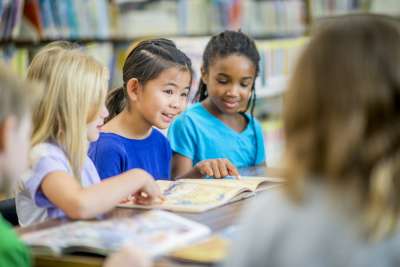A complete collection of resources for applying this critical reading strategy
Help your students be good readers with this resource. Includes strategies to help students learn how to use prior knowledge, questions to ask, the use of graphic organizers, reading conferences, and more. Lesson plans are also included. Students can also transfer their learning to other subjects.How Can You Make It Happen?
Start showing students how to make connections to their reading systematically and explicitly. Some teachers devote a good amount of time (6-8 weeks) to study a particular comprehension strategy in-depth before moving on to the next.
Begin by carefully choosing texts that can model how a proficient reader connects the text with experience. Picture books (even older students love them!) and shorter trade books that feature memoir writing are ideal texts to start with. Check the Resources section for a short list of books that are great for making connections. Use a variety of texts when teaching, including poetry and nonfiction books with different text structures and formats.
As you read the book with the class, "think out loud," stopping at appropriate points to articulate your thinking as a model for students. First, model connections between the text and your own experiences and encourage students to think of their own experiences that connect with the story. These are "text to self" connections. It is important during modeling to continually come back to the text and not allow personal experiences to divert the group from understanding the story. As students share connections, talk about how their experience helps them to better understand the text and how the text helps them to build their store of knowledge and experience.
The next connections to model are "text to world" connections. What do they know about the world that will help them to better understand the story? If they are reading When I Was Young in the Mountains by Cynthia Rylant or Tar Beach by Faith Ringgold, have them think about what they know about life in the mountains or in the city that can help them to better understand the story. If they are reading The Story of Ruby Bridges by Robert Coles, think about the background knowledge your students have about the Civil Rights Movement or segregation that could help them make sense of what they are reading.
Finally, model connections that are "text to text." Model how a book you are currently reading reminds you of another book you read with the class. Discuss similar styles of writing, characters, themes, or how both stories describe childhood memories of two different places. How does a book like Crow Boy by Taro Yashima, the story of a boy with hidden talents who is teased by his classmates, help students to understand a book like The Hundred Dresses by Eleanor Estes? Students can also think about what they know about authors based on books they have read by that author. They can predict what a story might be about, or if the style is similar in all of the author's stories.
With all of these strategies for connecting text to previous knowledge, it is crucial to talk with students explicitly about how this helps them to more fully understand what they are reading. It is also important for students to understand how they are building more prior knowledge with each book read.
How Can You Measure Success?
Much of the assessment for this comprehension strategy will be ongoing and informal observation of student understanding through participation in class discussion and in individual reading conferences with students. As students gain experience, you can monitor their progress through their entries in a reading response or reflection journal. Selected entries, chosen to show student progress over time, can go into a student reading portfolio along with completed graphic organizers, when appropriate, for various texts that the student has read throughout the year.
Lesson Plans
Prior Knowledge, The Popcorn Book
This lesson is designed to teach primary students how to activate prior knowledge before they begin reading. The lesson teaches students how to connect text to self, using the book The Popcorn Book, by Tomie de Paola. In this lesson, students make connections to themselves, their knowledge, and their experiences and help complete a KWL chart as the book is read aloud. This lesson is the first of a set of activating prior knowledge lessons designed for primary grades.
Prior Knowledge, A House Is a House for Me
This lesson is designed to teach primary students how to activate prior knowledge before they begin reading. The lesson teaches studentshow to make text-to-world connections using the book A House Is a House for Me, by Mary Ann Hoberman. In this lesson, students help complete a KWL chart by making text-to-world connections before reading the book and then make new text-to-world connections after reading. This lesson is the second in a set of activating prior knowledge lessons designed for primary grades.
Prior Knowledge, The Three Little Pigs
This lesson is designed to expand primary students' skills in activating prior knowledge before they begin reading. The lesson teaches how to connect text to text, using the book, The Three Little Pigs by James Marshall. In this lesson, students make connections to another event, setting, or character from another text that reminds them of the story they are reading. Students help complete a comparison chart and create their own text. This lesson is the last of a set of activating prior knowledge lessons designed for primary grades.












